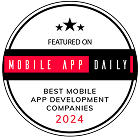How Much Does It Cost To Develop a Food Delivery App Like Jahez?
Did you know the food delivery market in MENA (Middle East and North Africa) is expected to reach $18 billion by 2025? Big apps like Jahez are already handling millions of food orders every month! If you are wondering what the cost to develop a food delivery app like Jahez, you are in the right place.
In this blog, we will discuss how much it costs to develop an app like Jahez. You will discover the cost bracket, the essential app features, the technology requirements, and clever ways to cut costs when creating your app.
So if you have ever considered launching your food delivery venture, keep reading—we have covered all the essentials, especially for you!
What is Jahez, and why is it so Popular?
Jahez is one of the most popular food ordering apps in Saudi Arabia. It also functions in some other locations such as Bahrain and Kuwait. Users adore Jahez as it provides an easy and entertaining way to order food.
You can stay at home, open the app, select what you want to have, and they will bring it to your doorstep. It is convenient and quick, and you do not even have to pick up a phone.
If you are planning to launch something similar, the cost to develop a food delivery app like Jahez
depends on the features, design, and team you hire, but the reward could be huge with the growing demand for food delivery services.
1. Jahez Business Model
Jahez earns money in different ways that help keep the app running and support the delivery system.
- Commissions from restaurants: This is Jahez’s biggest source of money. Jahez often receives 15% to 30% of the amount paid whenever somebody orders food from a restaurant. Suppose you buy shawarma for 50 riyals; you might have to pay an additional 10 to 15 riyals for the service.
- Delivery fee charges: You will pay a delivery fee when placing an order. This may be for a set price or could change depending on where you are located. Such expenses pay the drivers and cover the cost of delivering the food to you.
- Boosting ads and promotions: Restaurants can ask Jahez to show up more frequently in the app. This way, they receive more orders, and this benefits Jahez financially. It’s similar to getting a better place in the queue.
- Subscription plan (Jahez Prime): In Kuwait, Jahez launched something called “Jahez Prime.” Customers can pay monthly and get special offers like free delivery and discounts. This could be added in Saudi Arabia, too!
If you are thinking of building a similar app, you might wonder:
“Is it expensive to create a food delivery app in Saudi Arabia?”
Yes, it can be, but it depends on features, design, and how big you want to make it.
Core Features of Jahez
Let’s look at the key parts of the Jahez app that make it work so well. These features are what users, restaurants, and drivers use every day:
- Customer App: This is the main part that most people see. It helps you look at menus, order dishes, pay using the app, and follow your orders while they are being delivered. If you are wondering “What are the features of a Jahez-like app?”—this is the main one.
- Restaurant Panel: This part is used by restaurant owners. It helps them manage orders, update their menus, and see how many people are ordering from them.
- Driver App: This is for the people delivering the food. It explains the pickup and delivery locations to the couriers and organizes everything.
- Admin Panel: The Admin Panel manages every part of the app. The system is used by Jahez to add and remove users, resolve issues, and maintain everything working as it should.
These are the core food delivery app features, and they affect the cost to develop a food delivery app like Jahez.
Tech Stack Snapshot
So, how does the Jahez app actually work behind the scenes? It uses strong, modern technology to make sure the app runs fast and safely.
Backend (The engine of the app):
Jahez likely uses powerful tools like Node.js or PHP to run all the logic behind the app. This is what makes sure your order goes from your phone to the restaurant and then to the driver.
Mobile (The app that runs on your phone)
For the app to work across iOS and Android, they can rely on tools such as Flutter, Swift for iOS, and Kotlin for Android. They are used to better style the app and boost how quickly it is.
Cloud (Location of storage)
It is likely that Jahez relies on services like Amazon Web Services (AWS) or Google Cloud Platform (GCP). They prevent the app from crashing when many people are on it at the same time.
If you ask us, “Best tech stack for a food delivery app like Jahez?”, the answer includes all of the above!
Also Read – How to Patent a Mobile App Step-by-Step Guide in 2025
Core Features That Affect Food Delivery App Development Cost
So, what are the features of a Jahez-like app? Usually, a full food delivery system usually has four parts: a customer app, a restaurant panel, a driver app, and an admin panel. Each part needs special tools and design.
Customer App Features
This is the app your users (people ordering food) will use the most. It needs to be fast, simple, and fun to use. Some top features every on-demand app must have:
- Registration/Login
- Search
- Order Tracking
- Payments
- Reviews & Ratings
Restaurant Panel
Restaurants need their own system to manage everything on the app. This is where the food menu is uploaded and orders are handled. Common restaurant features include:
- Menu Management
- Analytics Dashboard
- Order Control
Delivery Driver App
Drivers need an app to get delivery details, pick up food, and find the customer’s location. Key features for this part of the app include:
- Navigation
- Earnings Summary
- Order Pickup & Delivery
Admin Panel
The admin panel is for the business owner or app operator. This is where everything is controlled from one place. It helps manage:
- Users – See and manage all customers, drivers, and restaurant partners
- Restaurants – Add new restaurant partners or remove inactive ones.
- Payments – Track transactions, refunds, and commissions.
- Analytics – Get reports on orders, earnings, user activity, and more.
Adding these features adds to the Jahez app development cost, but they are necessary for restaurants to stay organized.
Mobile App Development Cost Breakdown: 2025 Edition (Design to Launch)
The cost to develop a food delivery app like Jahez is broken down into several phases, each with its own associated expenses.
| Stage | Estimated Cost (USD) |
|---|---|
| UI/UX Design | $4,000 – $8,000 |
| Customer App | $10,000 – $25,000 |
| Restaurant Panel | $4,000 – $8,000 |
| Driver App | $6,000 – $12,000 |
| Admin Dashboard | $6,000 – $10,000 |
| Backend + APIs | $8,000 – $15,000 |
| QA & Testing | $3,000 – $6,000 |
| Launch + Support | $2,000 – $5,000 |
| Total | $43,000 – $89,000 |
So, the full budget for a Jahez-like app will likely range from $80,000 to well over $500,000. These estimates are just rough, and getting a proper quote means discussing your exact needs.
Factors Influencing Cost
When looking at the cost to develop a food delivery app like Jahez, it’s not the same for everyone.
Platform (iOS, Android, Web)
Building the app for more than one platform means more time, more testing, and more money. So, the food delivery app development cost gets higher if you choose to support multiple platforms.
Custom vs. White-label
A white-label app is already made, and developers just change the name, logo, and a few settings. It’s much cheaper and faster. Choosing between these two has a big effect on the cost to develop a food delivery app like Jahez.
Development Location (US vs. India vs. KSA)
Developers in the US usually charge the most. Developers in India offer the same skills for a much lower cost. Teams in Saudi Arabia (KSA) fall somewhere in the middle. If you are trying to lower the Jahez app development cost, hiring a team from India might be a smart option.
Feature Complexity
If you want real-time tracking, smart recommendations, loyalty programs, or in-app chat, the food delivery app development cost will go up. Complex features take more time to design and test.
Timeline to Build an App Like Jahez
Developing a full-fledged food delivery app like Jahez is a marathon, not a sprint. Here’s a general timeline:
| Phase | Timeframe |
|---|---|
| Discovery & Planning | 2–3 weeks |
| Design (UI/UX) | 3–4 weeks |
| Development | 10–16 weeks |
| QA & Testing | 2–3 weeks |
| Launch & Deployment | 1 week |
| Total | 4–6 months |
Food delivery app development in KSA requires 6 to 12 months, or even longer for highly complex platforms. For a Minimum Viable Product (MVP) with only essential features, you might be looking at 3-6 months.
Cost Optimization Tips
Building a high-quality app doesn’t mean you have to break the bank entirely. Here are some ways to optimize costs:
- Start with an MVP (Minimum Viable Product): Launch with only the essential core features to test the market and gather user feedback. You can add more advanced features in later phases. This significantly reduces the initial investment.
- Choose Cross-Platform Development (Flutter/React Native): Developing for both iOS and Android with a single codebase can save a lot of time and money compared to native development.
- Outsource Development to Regions with Lower Labor Costs: Countries in Eastern Europe, India, or other parts of Asia offer highly skilled developers at more competitive rates.
Use Ready-made Solutions/APIs: Wherever possible, integrate existing third-party APIs for functionalities like payment gateways, mapping, or push notifications instead of building them from scratch.
Also Read – How Much Does It Cost to Develop a Taxi App Like Hala
Must-Have Integrations
When thinking about thecost to develop a food delivery app like Jahez, one important part is the integrations you include. Integrations are tools and services that help the app work smoothly and give users a great experience. Adding the right integrations affects the Jahez app development cost and how well your app performs. Here are some must-have integrations for a food delivery app:
Payment Gateways: HyperPay, PayTabs
To let customers pay easily and safely, your app needs good payment gateways. HyperPay and PayTabs are popular options.
SMS/OTP: Twilio, Unifonic
For security and easy login, your app should have SMS or OTP (One-Time Password) features. Twilio and Unifonic are great choices. They send verification codes to users’ phones to confirm their identity.
Maps & Navigation: Google Maps, Mapbox
Food delivery apps need accurate location tracking and navigation. Google Maps and Mapbox help drivers find the fastest routes and help customers track their orders live.
Analytics: Firebase, Mixpanel
To understand how users behave and improve the app, you need analytics tools. Firebase and Mixpanel collect data about app usage, orders, and user preferences. Adding analytics tools may increase thefood delivery app development cost, but it is worth it to keep your app growing and successful.
ROI Potential and Monetization
A good food delivery app doesn’t just cost money to build—it can bring in steady income in several ways. Let’s talk about some common ways to earn revenue that help cover theJahez app development cost and turn your app into a successful business.
Delivery Fee Markup
One of the easiest ways to make money is by adding a small extra charge on top of the delivery fee. This is called a delivery fee markup. Every time a customer orders food, they pay a bit more for delivery. This extra money goes to the app owner.
Vendor Commission
You can also collect a commission from the restaurants or vendors who post on the platform. Each time a restaurant gets an online order, the app receives a percentage of what the customer paid. Higher sales for restaurants lead to more money for the app.
Featured Listings
Restaurants want to stand out from the competition. You can offer them the chance to pay for “featured listings.” This means their restaurant shows up at the top of search results or on special sections in the app. Featured listings cost money, but they help restaurants get more orders. This creates another way for your app to earn revenue while helping restaurants grow.
Ads & Promotions
App developers can also make money from ads and promotion features within their apps. App publishers could find that local businesses, food brands, or restaurants are interested in using their app for advertising. You can charge them for this advertising space.
Case Study: How Jahez Reached a $2.5B Valuation
Jahez’s journey to a $2.5 billion valuation is a testament to the immense potential in the food delivery market, especially when a company deeply understands its local audience. While specific strategies are proprietary, some general factors likely contributed:
Early Mover Advantage
Jahez started early, before many other food delivery apps in Saudi Arabia. Being one of the first helped it grow fast and become a well-known name. People already trusted it by the time new apps showed up.
Strong Delivery Network
Jahez built a solid system for deliveries. Orders got to people on time and were still hot. A fast and reliable delivery system made customers happy and more likely to order again.
Expanding to New Cities
The company kept growing and opening in more cities and regions across Saudi Arabia. This helped it reach even more people and restaurants.
Big Investor Support
Because the company was growing quickly and leading the market, lots of investors wanted to support it. That gave Jahez the money it needed to grow even more and improve the app.
Smart Technology
Jahez always worked on making the app better. They added new features, made it easier to use, and fixed problems fast. A smooth app experience made users want to stick with them.
Common Mistakes to Avoid
There are some typical errors to avoid if you are building a food delivery app like Jahez. Such errors may take away your time, money, and even the customers you have. We can look at them one after the other.
Underestimating Backend Complexity
If you don’t plan this part well, your app might crash or work super slowly. That can make users really frustrated. So, always make sure you are working with developers who understand how complex the backend needs to be.
Poor UX in Driver and Vendor Apps
Most people focus only on the customer app, but don’t forget about the drivers and restaurant vendors. If their app is confusing or hard to use, orders might get delayed or delivered wrong. UI/UX trends for food delivery apps help the whole system run better.
Lack of Real-Time Tracking
If your app doesn’t have real-time tracking, customers might get annoyed or worried. Real-time tracking helps everyone stay informed, so don’t skip this feature!
Ignoring Local Compliance and Tax Laws
Every country — and even city — has different rules about food, business, and taxes. Some new app makers forget to check these things. That can lead to big legal problems or fines later. It’s super important to talk to a lawyer or someone who knows the local laws before launching your app.
Also Read – How Kotlin Multiplatform is Transforming Mobile App Development













.png)


